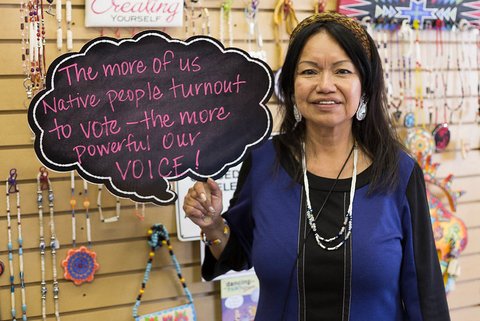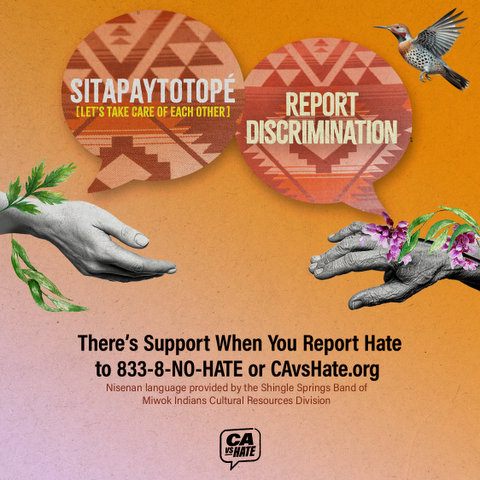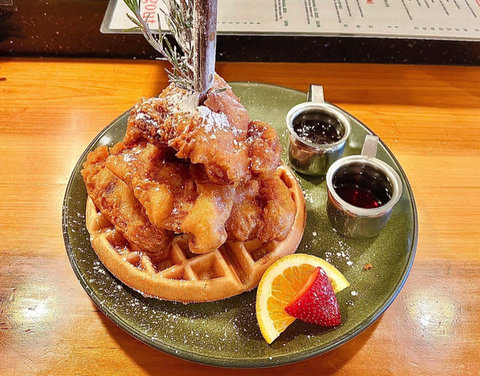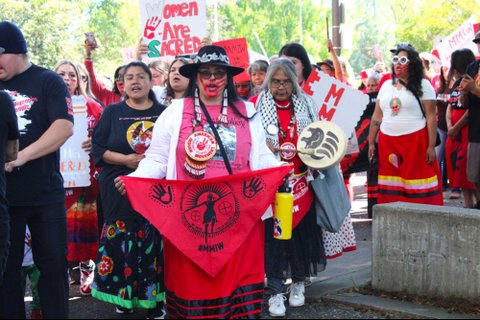
01 Nov Native Americans Often Excluded From Voting

(“Warm Springs Native Vote” by Alyssa Macy for Confederated Tribes of Warm Springs, Oregon / Flickr / CC BY-NC-ND 2.0 license)
By Joe Porrello
Election Day is fast approaching, and in one recent past election, a predominantly Indigenous community in South Dakota was told to vote in a chicken coop. Elsewhere, many Native voters can’t rely on voting by mail — something meant to make voting more accessible — because of poor service.
Around the U.S., racism and poor infrastructure alike prevent many Native Americans from exercising their right to vote. Native American Rights Fund senior staff attorney Jacqueline De León, who leads the Native American Voting Rights Project, spoke to the issue during a March 20 meeting of the California Commission on the State of Hate.
Just getting on the voter rolls can be a challenge.
“We saw that registration opportunities were much, much less equitable — if they occurred at all on Indian reservations,” she said. “We may have 2,000 eligible voters and less than 250 registered, and that’s because voter services aren’t on the reservation.”
So along with California Secretary of State Shirley Weber, NARF helped lead an effort to make 638 Native American Indian Health Services facilities into designated national voter registrations sites.
After co-leading nine field hearings in California on voting with 120 witnesses from Indian reservations, De León said one common theme emerged: Voting services are not accommodating to Native Americans.
>>>From Our Archives:
Native American Vote Has to Overcome Many Barriers<<<
This contributes to the percentage of Indigenous voters being lower than any other ethnicity, noted De León. Their numbers can be so low they’re often not officially counted in voter demographics.
“We get labeled with this idea that Native American communities are apathetic and just don’t want to vote, but I think what all of these factors are showing is that Native communities… are being told over and over that the system is not for them,” said De León.
She said voter turnout is also low among Natives because polling places can be practically inaccessible.
“Traveling great distances on poor roads is very difficult,” she said. “If you don’t have a vehicle because you’re impoverished, it can make travel impossible.”
>>>Read: Fraudsters Prey on Vulnerabilities to Scam Native Americans<<<
And voting by mail isn’t necessarily any easier as many Native Americans don’t have traditional mailing addresses or regular postal service.
“It’s not as easy to just drop your ballot outside your door if you don’t have mail delivery,” she said.
De León said some Native American communities in California can go months without their mail being picked up, and they don’t feel confident their votes will be counted.
“We get testimony that the vote-by-mail services in rural areas in California were less trustworthy than outside areas in cities and that tribal communities do not trust their mail service,” said De León.
Those who do overcome these and other barriers are frequently met with racist hostility.
“They just don’t see Native Americans as part of the system that is entitled to vote,” she said.
>>>From Our Archives:
Voting Districts Are About to Be Redrawn. Here’s Why It Matters<<<
That’s when De León brought up the chicken coop in South Dakota and a hotel there that as recently as 2022 had a sign forbidding Native Americans.
“To say that we’re back in the 1960s level of discrimination is not an overstatement,” she said.
One Montana county offered in-person voting services during the pandemic to one 90% white town but not on a reservation because they “didn’t want to catch COVID from a Native person,” De León said a worker told her.
“People that are willing to take risks for people who look like them but not take risks for Native Americans … ,” she said, is “racism that affects the types of voter services that they get.”
In areas surrounding reservations, Indigenous people often experience discrimination because of political differences and “long-rooted racial tensions.”
>>>Read: ‘History of Violence’ Against Native People Continues Today<<<
Similarly, tribal members who spoke during the California field hearings said they felt uncomfortable in border towns because of microaggressions they encountered.
“In our border town, we often experience a lot of racism and hate, so it was very vital my members were going to get that opportunity to vote in a place where they felt comfortable; they felt respected,” said Regina Cuellar, chairwoman of the Shingle Springs Miwok Indians, referring to the efforts to bring voter services to IHS facilities.
“The community sentiment in these border towns can be fairly clear, and that in itself is intimidation in the voting context,” De León said.
And that may be a sign of a larger problem to come.
“There is fear that in this upcoming election, Native populations — in rural areas especially — may be subjected to intimidation and, worst case, violence,” she said.
>>>Read: ‘A Kind of Medicine’: Indigenous People March in Santa Rosa to Remember the Missing and Murdered<<<
In response, NARF will monitor polling places on Election Day, as it has in the past.
Barriers to voting are not the only way Native Americans are excluded from the political process.
For example, said De León, “we’ve seen voter officials backdate false complaints to get Native American candidates kicked off of ballots.”
She said more people need to recognize that Native Americans are both sovereign — i.e., self-governing — and U.S. citizens as well as full members of their counties and states. And as such, they are entitled to seats of government and equal rights, including voting.






No Comments